What good are spiders? Are they of any ‘use’ on my block? How do I encourage more of them? Maybe these questions are at the top of your list, maybe not, but hopefully this article goes some way towards answering them.
For some people, spiders are a visual torment. Others just love them. Most of us just let them be. And that is the best way to conserve spiders. Spiders can be found in all manner of habitats: tops of trees, under bark, in leaf litter, in burrows, along creeks and even out in the ocean.
Spiders have evolved over a very long time into a huge number of species that have a huge array of adaptations to thriving on Earth. It is estimated that there are about 10,000 species of spiders in Australia, but only about 3,500 have been named. They are an integral part of the biota (fauna and ora) that drives our very existence. They eat mainly insects and, in turn, are eaten by a host of other species.
Spiders can broadly be divided into two main sections: mygalomorphs (primitive spiders) and araneomorphs (modern spiders). The mygalomorphs are one of the oldest known terrestrial invertebrate groups and have remained almost unchanged for millions of years. Mygalomorphs are generally large bodied, with two pair of ‘booklungs’ (external bags used for breathing) and downward-striking fangs. Araneomorphs are generally smaller or less robust than mygalomorphs and only have one pair of booklungs and one pair of tracheal tubes making them more tolerant to drier environments. They also have opposable fangs that close sideways.
Mygalomorphs include trapdoor, funnelweb, wishbone, tarantula and mouse spiders. Due to their choice of habitats, they are a great indicator of stable micro- climates. Mygalomorphs live in tunnels that they construct into soil; therefore they require soft, moist soil suitable for digging. Most mygalomorphs are thus found along creek banks, soaks and rainforests. These areas were probably refuges for mygalomorphs and a range of other animals during the last Ice Age (~20,000 ya), and they have probably not moved location since then. If you have trapdoors on your property, then you have stable refuge areas, which are very important or conservation. Dr Robert Raven, Head of Arachnology at the Queensland Museum, recommends that landholders pay particular attention to keeping these refuge areas safe for the future.
Nearly all spiders produce a magical substance called silk. It is an organic polymer produced in special glands called spinnerets. Spider silk can be produced with a wide range of properties, from thick and strong like a rope, to curly and springy, to lumpy and sticky, all on demand to suit the situation. It is a valuable substance so spiders usually recycle it, otherwise the world would be covered in thick layers of silk. I know the tracks through my bushland seem to be covered in silk, as I am always walking into a web, but somehow it all seems to quickly disappear.
Here is a brief overview of some spider families that you may encounter in SEQ.
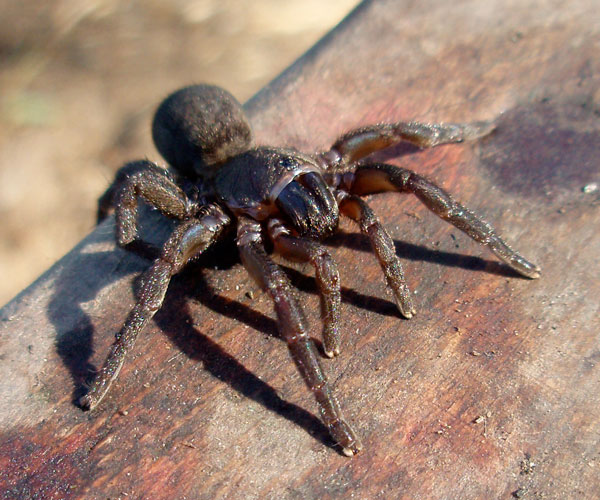
Brush-footed Trapdoors are common around Brisbane. Photo by Robert Whyte.
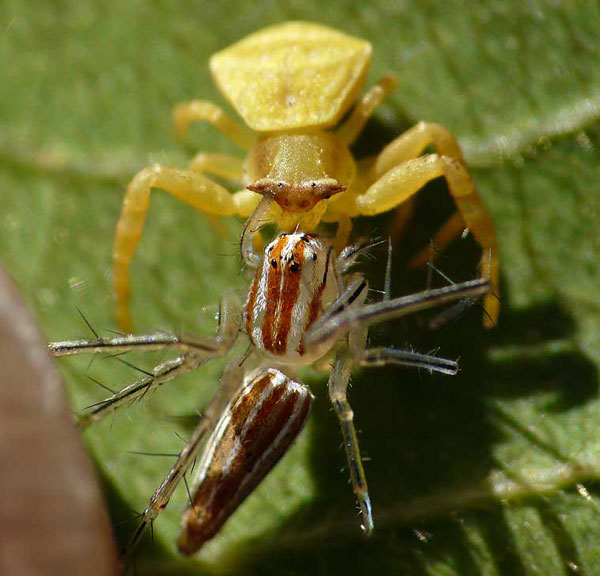
A yellow Spectacular Crab Spider (Thomisus spectabilis) biting a Lynx spider (Oxyopes
macilentus). Photo by Robert Whyte.
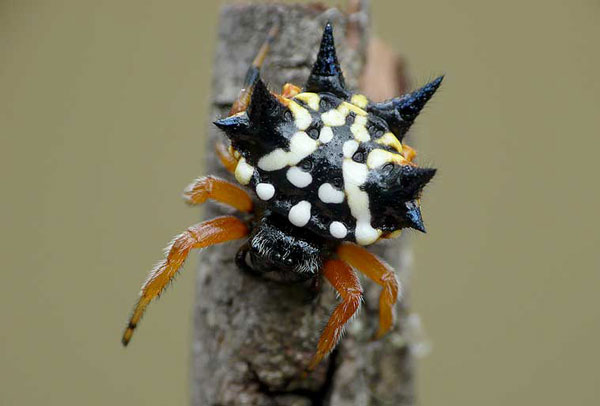
Australian Jewel Spider – one of the Spiny Orb-Weaving spiders. Photos by Robert Whyte (www.arachne.org.au).
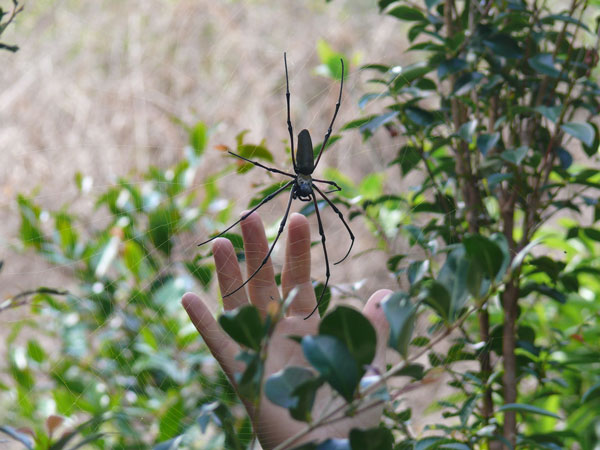
A Northern Golden Orb Weaver (Nephila pilipes) – the largest spider in SEQ. Photo by Deborah Metters
Mygalomorphs
Trapdoor Spiders. They usually live in burrows made in damp places, often
with a door that can be very cleverly camouflaged. They usually build trip wires around their door and wait for some unsuspecting insect to wander past and hit the trip wire, upon which the trapdoor will leap out and grab their prey. Females live for up to 40 years and moult every year. Males go exploring for females and therefore are more likely to come into contact with humans.
Funnel-web Spiders.
They have a fearsome reputation with venom toxic to humans. Funnel-webs do not directly inject venom but push a drop of venom into a victim with their fangs. Luckily the venom usually gets lost on clothing. Once venom has been produced it takes a month to produce more, so many strikes are dry. They build a distinctive funnel entrance to their burrows.
Araneomorphs
Orb Weaving Spiders (Araneidae). These are the ‘classic’ spider sitting in the middle of a round web. It is a huge family with currently 268 species. These spiders build
a web to catch prey (usually flying insects) and also hide from predators in all manner of disguises. The constant battle for all species is to eat without being eaten! Some commonly encountered species include the large Garden Orb-Weaver with a strong web across the garden path about face high; St Andrews Cross Spider with a distinctive cross-shaped pattern; Tent Web Spiders that hide in a large web the shape of a tent; Spiny Orb-Weavers with colourful ornate appendages on their backs; the Magnificent Spider that hunts by using a line of silk with a sticky drop on the end and emitting pheromones that attract the males of certain moths; Bird-dropping Spiders that looks like a dropping of a bird and also emit a pheromone to attract prey; and, Leaf-curling Spiders that hide in a curled-up leaf.
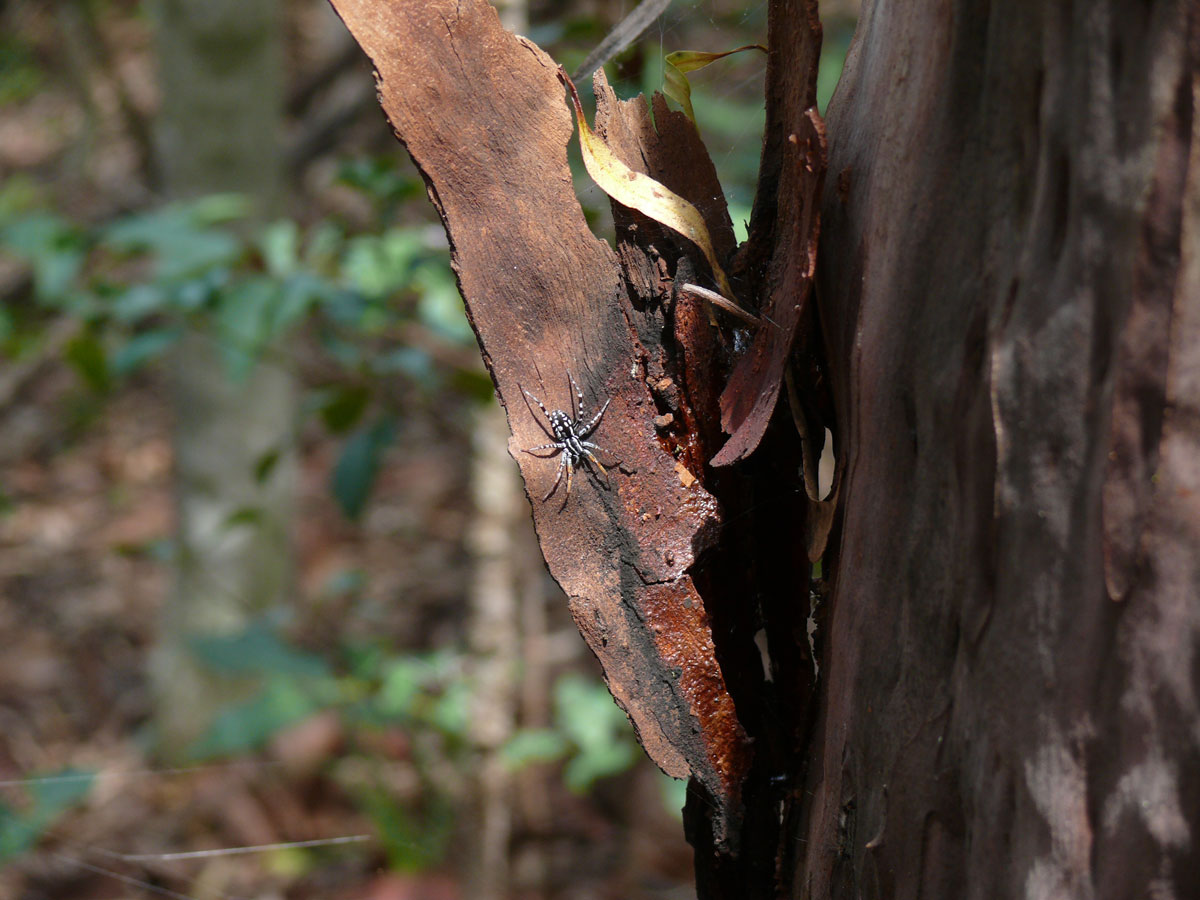
Orange-legged Swift Spider (Nyssus coloripes) hiding underneath bark.Photo by Deborah Metters.
Golden Orb Spiders (Nephilidae).
These are some of the largest spiders in SEQ, with a leg-span reaching over 15 cm and sitting boldly in the centre of a large golden web. There are three species of Golden Orbs here in SEQ.
Net-casting Spiders (Deinopidae ). They are rather unique in the spider world with long legs and a special capture net that is opened and thrown over unsuspecting prey. They weave this special web and hold it between their legs and wait.
Huntsman Spiders (Sparassidae). This is a large family with over 150 species. They often run around inside our homes so everyone is familiar with them. They may bite, but their bites are never serious. Huntsmen are well adapted to hunting at night and hiding under bark and in small crevices. They don’t make webs. They can climb smooth vertical surfaces and have eight beady eyes in two rows to stare you down. They don’t like wind, so they often come inside our homes when it is windy outside. The best way to get them out of your house is to simply turn on a fan.
“If you have trapdoors on your property, then you have stable refuge areas, which are very important for conservation.”
Ant-eating Spiders (Zodariidae). These spiders are closely associated with ants and some even mimic ants by holding up their first pair of legs to look like ant antenna, and even producing pheromones to stop ants attacking them. There are over 250 species. They are small, black and shiny. Many have colourful spots on their abdomen.
Wolf Spiders (Lycosidae). These large, hairy spiders hunt for prey on the ground and build burrows. Shine a torch at night across the lawn and all the bright eyes looking back at you are wolf spiders hunting. You may also find lots of burrows in the lawn. These spiders are noted for their care of baby spiderlings as the young cling to mum until they are ready to leave.
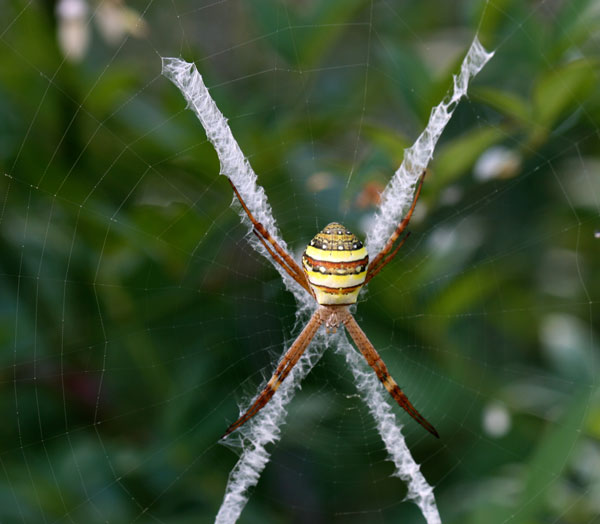
St Andrews Cross Spider and its distinctive web.
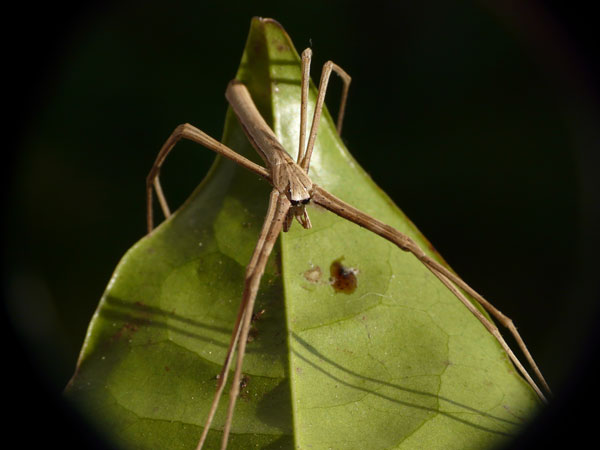
A Common Net-casting Spider (Deinopis subrufa). Photo by Robert Whyte.
Crab Spiders (Thomisidae). These are masters of concealment using their camouflage to ambush prey. They are also called flower spiders and they hide in flowers waiting for a bee, butter fly or ant to come along. Shaped like little crabs they are very distinctive and often multi- coloured. They are quite strong and can capture much larger prey.
Jumping Spiders (Salticidae). These are the pin-ups of the spider world. With their two big front eyes looking at you, plus their bright colours and small size, they are so cute. The tiny male Peacock Spider is the latest ‘in thing’ with its ability to are out its stunning colourful abdomen while dancing (several Youtube clips show this). Jumping spiders are noted for their jumping, usually with a silk line attached. This is a large family with up to 400 species across Australia.
Swift and Ant-mimicking Spiders (Corinnidae). These are very fast ground hunting spiders. Many are ‘Batesian mimics’ of ants that try to look like an ant species that is toxic and therefore avoided by predators. Mimicry can be quite complex as some mimics mimic other mimics!
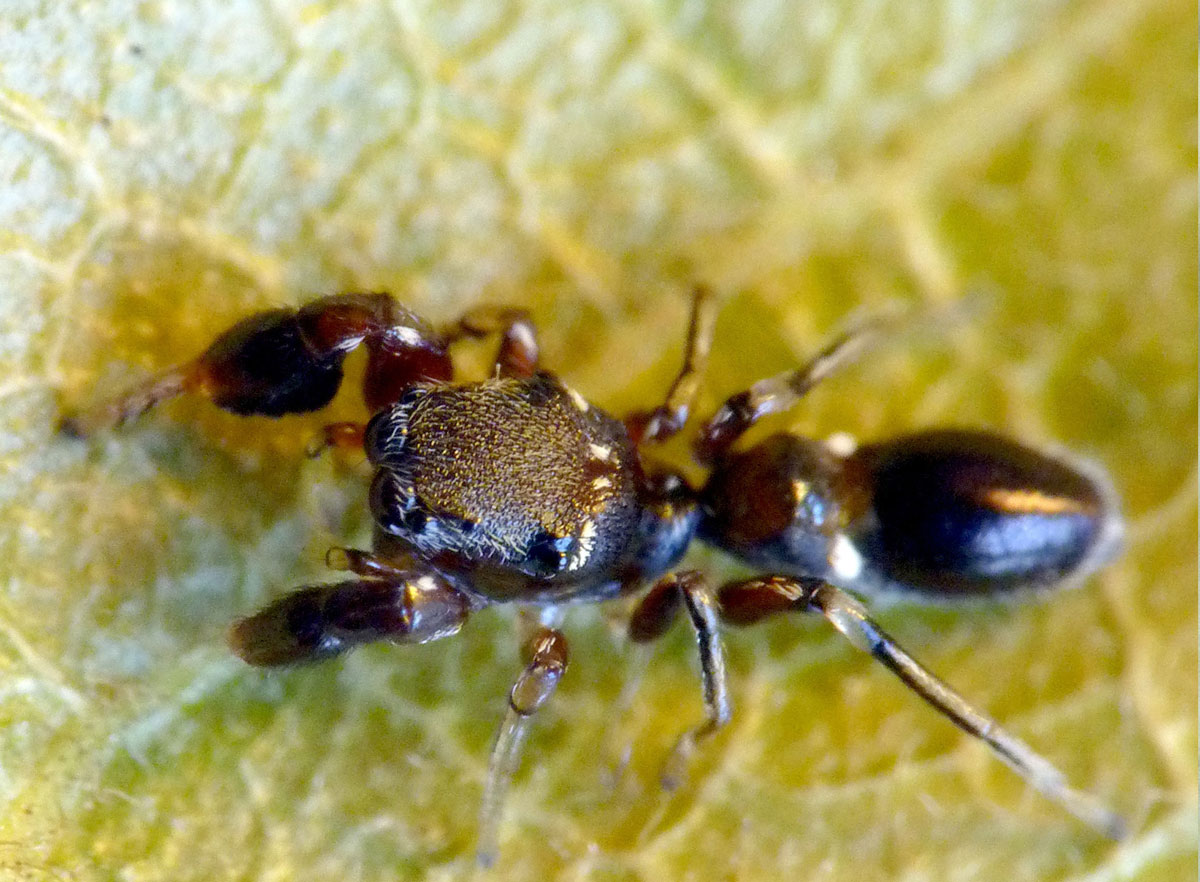
An ant-eating ant-mimic (Rhombonotus sp.). Photo by Robert Whyte.
These are just some of the spiders found around SEQ. The Queensland Museum estimates that most native bushland areas contain about 700 spider species. All of these are performing some ecological roles such as controlling other insects and providing food, as prey, for birds, reptiles, bandicoots and other animals.
You are likely to find an un-named species on your Land for Wildlife property if you start searching. Spiderus mccoshii has a ring to it, don’t you think?
References and Further Reading
Framemau VW, Baehr BC & Zborowski P (2014) A Guide to the Spiders of Australia. New Holland Publishers.
Raven R & Seeman O (2008) Spiders of the Greater Brisbane Region. A Queensland Museum Wild Guide.
www.qm.qld.gov.au
www.arachne.org.au
Article by Keith McCosh Land for Wildlife Officer Scenic Rim Regional Council
